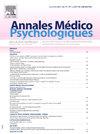Deuil des racines, racines des deuils : à propos d’un cas clinique
IF 0.5
4区 医学
Q4 PSYCHIATRY
引用次数: 0
Abstract
Introduction
Wars and/or natural disasters have long been sources of trauma. Today, it has been demonstrated that migration can also constitute a traumatic reality. Migration can be an acute traumatic phase for some people, even if not all traumas always have negative effects and not all individuals are at equal risk of traumatization. Whether voluntary or forced, Migration remains a particularly trying ordeal and a crisis, which imposes a logic of breaking historical cultural references, changing social references, a reorganization of identity and a psychological transformation. It involves a loss of cultural heritage and the discovery of new resources and potential. Indeed, people who go into exile lose their home, their kinship, their language, their community and their roots. In addition to the various losses suffered, the subject is assailed by existential questions, essentially affecting their identity in their relationship with dyads: sameness–selfhood, time–space, here–there; present–future; illusion–reality, etc.
Method
Based on a clinical vignette drawn from our experience in the psychiatric field, we propose to reflect on the psychological and cultural determinants linked to the issue of grief and trauma. This case concerns Mr. B., admitted for major anxiety-depressive syndrome characterized, among other things, by moodiness, loss of appetite and sleep, and psychomotor retardation. He stopped going to work without any specific reason and had lost his usual lifestyle habits (sport, reading at bedtime, lullabies for the children). In addition to antidepressant treatment and the exploration of possible etiopathogenic factors, such as the migratory trajectory, it was possible to co-construct a transcultural psychotherapy program with the patient and his wife, where cultural data served as therapeutic levers. As such, the migratory trajectory taken as an intercultural variable can be considered here as one of the etiopathogenic factors of depressive syndrome or other related disorders to the extent that it reactivates the ontological elements linked to the basic personality of the subject and confronts them in another universe, that of the host or adopted country. In this configuration, it was necessary for us to mediate between the maternal uncle and the couple following the example of transcultural mediation developed by Bouznah.
Conclusion
The caregiver's understanding of these determinants will thus allow for a therapeutic approach adapted to the patient from a different world of meaning, considering not only cultural signifiers, but also the thought patterns to which they refer in relation to the question of normal and pathological. This clinical case raises several observations that influence the therapeutic approach to patients in migration situations. The first observation concerns decoding the cultural meaning given to the question of normal and pathological. Indeed, this decoding is based on the premise that “every culture defines categories that allow us to read the world and give meaning to events”. The second observation concerns access to the interpretation of the patient's etiological system. Mr. B indicated that the antidepressant treatments administered to him will not be able to cure his illness. His illness is not natural. It is the consequence of disobedience towards an important symbolic figure: his maternal uncle. The third observation is rooted in the two others cited above and concerns the need to use certain cultural references of the patient as therapeutic levers. Based on the patient's and their family's narrative, a cultural ethos was mobilized to unleash the sacred value of speech within the symbolic order of the patient's culture. The fourth observation concerns the need to determine the profiles and different defensive arrangements of patients belonging to other cultures. This serves as a compass to guide the way in which clinical investigations and the therapeutic proposals that follow will be conducted. This article clearly constitutes one of the gateways to addressing the question of the roots of grief, highlighting the impact of cultural substrates in an in-between situation and enriching the field of inter- and transcultural clinical practice.
悲伤的根源:临床案例
长期以来,战争和/或自然灾害一直是创伤的来源。今天,事实证明,移徙也可能构成一种创伤性现实。对一些人来说,移民可能是一个急性创伤阶段,尽管并非所有创伤都有负面影响,并非所有人都有同样的创伤风险。无论是自愿的还是被迫的,移民仍然是一个特别艰难的考验和危机,它强加了一种打破历史文化参照、改变社会参照、重新组织身份和心理转变的逻辑。它涉及文化遗产的丧失和新资源和潜力的发现。事实上,流亡的人们失去了他们的家园,他们的亲属关系,他们的语言,他们的社区和他们的根。除了所遭受的各种损失之外,这个主题还受到存在主义问题的困扰,这些问题本质上影响了他们与二人组关系中的身份:同一性-自我、时空、这里-那里;present-future;方法根据我们在精神病学领域的经验得出的临床小插曲,我们建议反思与悲伤和创伤问题相关的心理和文化决定因素。本病例涉及B先生,因严重焦虑抑郁综合症入院,其特征之一是情绪低落,食欲不振,睡眠不足,精神运动迟缓。他没有任何特别的原因就不去上班了,也失去了他平时的生活习惯(运动、睡前阅读、给孩子们唱摇篮曲)。除了抗抑郁药物治疗和探索可能的致病因素(如迁移轨迹)之外,还可以与患者及其妻子共同构建一个跨文化心理治疗项目,其中文化数据可以作为治疗杠杆。因此,作为跨文化变量的迁移轨迹在这里可以被视为抑郁综合征或其他相关疾病的致病因素之一,因为它重新激活了与主体基本人格相关的本体论要素,并在另一个宇宙,即东道国或被收养国的宇宙中面对它们。在这种情况下,我们有必要按照Bouznah提出的跨文化调解的例子,在舅舅和夫妇之间进行调解。因此,护理人员对这些决定因素的理解将允许治疗方法适应来自不同意义世界的患者,不仅要考虑文化能指,还要考虑他们与正常和病理问题相关的思维模式。这个临床病例提出了一些观察结果,这些观察结果影响了对迁移情况下患者的治疗方法。第一个观察涉及解码正常和病理问题的文化意义。事实上,这种解读是基于“每种文化都定义了允许我们解读世界并赋予事件意义的类别”这一前提。第二个观察涉及对患者病因系统的解释。B先生指出,给予他的抗抑郁治疗不能治愈他的疾病。他的病不是自然的。这是对一个重要的象征性人物不服从的结果:他的舅舅。第三个观察根植于上面提到的另外两个,涉及到需要使用患者的某些文化参考作为治疗杠杆。以患者及其家属的叙述为基础,动员一种文化思潮,在患者文化的象征秩序中释放言语的神圣价值。第四个观点涉及需要确定属于其他文化的患者的概况和不同的防御安排。这可以作为一个指南针来指导临床研究和后续治疗建议的实施方式。本文明确地构成了解决悲伤根源问题的门户之一,突出了文化基质在中间情境中的影响,丰富了跨文化和跨文化临床实践领域。
本文章由计算机程序翻译,如有差异,请以英文原文为准。
求助全文
约1分钟内获得全文
求助全文
来源期刊

Annales medico-psychologiques
医学-精神病学
CiteScore
1.30
自引率
33.30%
发文量
196
审稿时长
4-8 weeks
期刊介绍:
The Annales Médico-Psychologiques is a peer-reviewed medical journal covering the field of psychiatry. Articles are published in French or in English. The journal was established in 1843 and is published by Elsevier on behalf of the Société Médico-Psychologique.
The journal publishes 10 times a year original articles covering biological, genetic, psychological, forensic and cultural issues relevant to the diagnosis and treatment of mental illness, as well as peer reviewed articles that have been presented and discussed during meetings of the Société Médico-Psychologique.To report on the major currents of thought of contemporary psychiatry, and to publish clinical and biological research of international standard, these are the aims of the Annales Médico-Psychologiques.
 求助内容:
求助内容: 应助结果提醒方式:
应助结果提醒方式:


